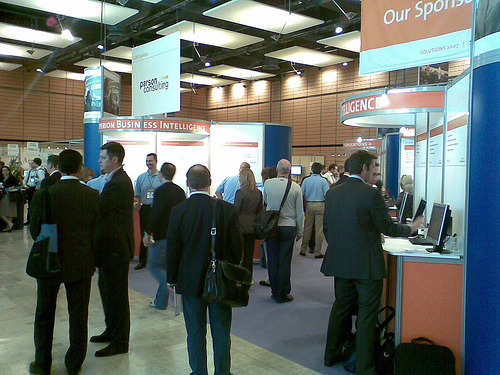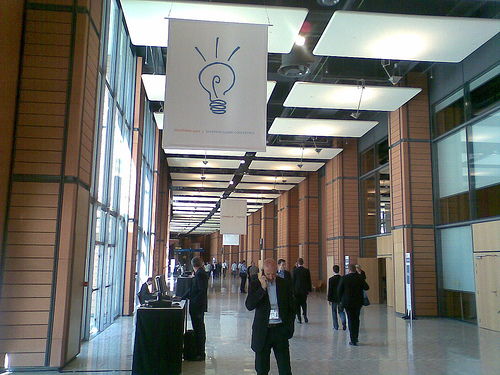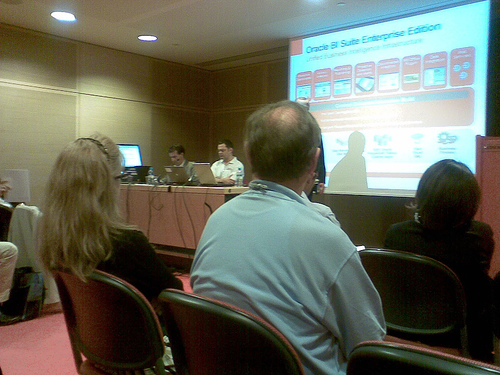Thoughts on the Hyperion Conference, Lyon
It's just after 3.30 in the afternoon in Lyon, and I'm just about to finish up at the Hyperion conference. I've deliberately held back from posting to the blog until today, as I wanted to take things in for a while as it's all just so different from an Oracle conference. The format and so on is the same, but all the products, technologies, speakers and so on are obviously from the Hyperion world, which is just that little bit different to what we've got used to in the world of Oracle.
I'm over here on a dual mission; firstly, I'm an official representative of the UK Oracle User Group, and I'm looking to speak with Hyperion users, some of the speakers and ideally make contact with the Hyperion user group people, to see whether there's any scope for working together in the UK and Europe. Secondly, putting my consulting hat on, I'm keen to see what Hyperion have to offer and what plans Oracle have to integrate their technology into the Oracle BI&W stack.

User group stuff first: although the products are different, there's clearly a lot of common ground and I expect many, many users of Hyperion are also users of the Oracle database, Oracle BI tools, E-Business Suite, Peoplesoft, JD Edwards and Siebel CRM. The planning and budgeting issues that Hyperion users encounter are the same ones that users of EPB, OFA and Peoplesoft EPM have, and it's obvious to me that the UK Oracle User group would be a great resource for users of Hyperion tools who want to discuss issues and best practices with their peers. When I get back, I'll be speaking with the Hyperion User Group head in the UK, and with the UKOUG directors, to see what we can do together. With a bit of luck, we'll have some speakers on the Hyperion tools at the upcoming conference in December, and at future BIRT SIGs, so if you're a Hyperion users looking to find out what's coming up, get in touch with me or check out the UKOUG website.
On to the technology now. The event was clearly a Hyperion event, with participation from Oracle now that the two companies have merged. Oracle had a presence in the demo grounds, took part in the keynote, and had a couple of presentations that looked likely to set out what their plans for the merged company are. What I found in practice was that there was a fair bit of detail on what Oracle are planning at a high level - strategic direction, rationale for the purchase and so on - whilst specific details about what's happening with each of the products being left out for the time being. Unfortunately, I missed the keynote on Monday morning, but I had quite a long conversation with some fairly senior Oracle people and also sat through the webcast of Thomas Kurian's presentation at the same event in the States a few weeks ago, and it seems like the current story is this:
- Oracle purchased Hyperion because of their financial planning tools.
- The BI story now is around Enterprise Performance Management. This is defined as the bringing together of financial management tools (i.e. the ones from Hyperion), operational business intelligence tools (the ex-siebel ones) and data from ERP systems such as E-Business Suite, Peoplesoft, JDE and Siebel. Hyperion was purchased to add the financial planning element to Oracle's BI offering, which was missing before (at least to the required quality)
- Whilst the general direction is now defined, no details at this point are being released about which tools are now the strategic direction; having said this, it seemed clear to me that BI Suite Enterprise Edition will play a key role, together with Hyperion's planning apps and presumably the Essbase OLAP engine that powers them. Less clear was the role of System 9 (more on this later) and Essbase as a standalone development platform.
The main products that I was interested in finding out more about were Essbase, System 9 and the Financial Planning apps. I'll come on to Essbase and the apps in a moment, but the tool that held the most suprises for me was System 9, the "framework" that Hyperion now sell that wraps up the planning apps, the reporting tools and the Essbase toolset. It turns out that System 9 is quite heavily based on the old Brio toolset (which is now named "Interactive Reporting"), with dashboards, query tools, security and so on.

To me, it seems that if Oracle are going to keep System 9, they're necessarily going to have to keep the old Brio elements, on which it's largely based. From speaking to a few people, the future and role of System 9 seems different depending on who you speak to; on the one hand, it will be the gateway in to all Oracle's BI apps (there's a tool called "Workspace" that provides an icons and folders view in to all analytic content), whilst according to others, it'll be kept on but narrowly focused on supporting the planning apps. I think to be honest, no-one really knows yet, the details haven't been sorted out, and like all tool mergers, there are good and bad parts of both tool sets.
My educated guess at this point is that, if Oracle are planning to introduce this new concept of Enterprise Performance Management, which encompasses operational, financial and transactional reporting, they're going to introduce some new portal or gateway that brings them all together - this may well involve some use of Hyperion-derived technology. The bulk of what we'd call traditional BI reporting will be still done using the Siebel Analytics-derived tools, with elements of Essbase-backed Hyperion planning tools used to add the financial planning element (although not all Hyperion apps use Essbase, some use their own relational stores). Certainly tools such as Hyperion Planning and Hyperion Crystal Ball were mentioned many times, these are obviously going to be key going forward.

Interactive Reporting (previously Brio) was an interesting technology. It's like Discoverer in that it's an ad-hoc query tool against relational data (integration with Essbase is coming soon, apparently). To me it seemed a bit primitive compared to Discoverer - there's no End User Layer/Semantic Layer, you go direct against the database using ODBC, for example, with joins and so on being set up on a report-by-report basis - but the developers I spoke to raved about it because of it's flexibility, scriptability and so on. My take on this is - like Discoverer, I can't see it being the strategic direction for ad-hoc reporting going forward, I think the emphasis in the future will be on integration with the Oracle BI Server (so it can work with integrated data and a semantic layer), Integration with Essbase and it's role in System 9, for those customers staying on the Hyperion track. An interesting tool, superficially similar to Discoverer but a bit more "programmable".
Essbase was very interesting. I was lucky enough to spend a bit of time with some people who knew both Essbase and Oracle Express/Oracle OLAP, and I sat through quite a few beginners talks and ones on new features. My initial impressions are that Essbase to me looks like Oracle Express would have been had Oracle not spent the last five years integrating it into the database; the tools are much more developed (although more complicated, more on this in a moment) and there's far more of a customer base and developer ecosystem. Certainly, looking at tools such as Smartspace for Microsoft Office (a super-duper Office add-in), Visual Explorer (based on the Tableau product) and the new Analytic Studio, they're far more developed than tools such as Analytic Workspace Manager and the old Express Administrator.
There's a downside to this, though. Although the tools are more powerful, they're also more complicated; administering Essbase at the moment involves working with lots of different tools, and the two storage options available with Essbase - the traditional Block Storage Option, which is more flexible but doesn't scale as well, and the new Microsoft Analyis Services-style Aggregate Storage Option, which scales better but isn't quite as flexible/has the same calculation ability - makes things complicated for developers, with different storage options capable of different things. Overall, my impression is that, in terms of the end product, i.e. a multi-dimensional cube for users to query - Essbase and Oracle OLAP are probably in the same ballpart in terms of ability, performance and so on, but they get to that point in very different ways. Essbase is probably more controllable, more flexible, has more options, but is more complicated, whilst Oracle OLAP (in it's 10gR2 version) hasn't got quite so many options, or as sophisticated a set of tools, but is probably easier to manage. I think for myself, I'll try and send myself on the Essbase bootcamp and get myself to the point where I'm at least familiar with Essbase development, but as I don't plan to get in to the financial apps, I'll stick with Oracle OLAP as my primarly OLAP server.
Anyway, for now, that's my take on the conference. From a user group perspective, I hope the Hyperion user base gets involved with the UK Oracle User Group as I think we'll have a lot in common. From a technology perspective, there's a lot of interesting products there - Essbase, with it's rich heritage, well developed tools, perhaps a bit scary architecture and a large and vocal user and development community; the financial planning apps, best of breed and due to make a big impact in the Oracle BI world, and the Brio/System 9 tools, a bit of a mixed bag and not something I'm too sure about for the time being. I'm currently sitting in the lounge at Lyon Airport and due to fly back to the UK at 7pm, so for now that it's it for me, and time now to get down and dirty with the BI and SOA stuff.